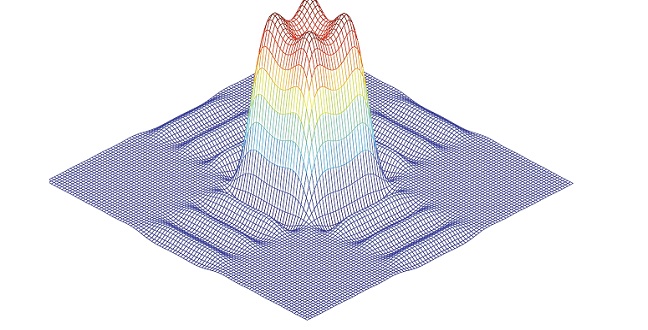Electrical Engineering
The crest of waveforms for next-gen radar
A new method for shaping the waveform generated by multi-antenna radar systems is inexpensive and practical.


An example of beam pattern shaping using KAUST’s MIMO waveform computation scheme.
Reproduced with permission from ref 1© IEEE
By adapting the interaction between several independent radar transmissions in real time, KAUST researchers have shown that it is possible to vastly improve target identification and range using multiple input, multiple output (MIMO) radar systems.
Radar is used extensively in civilian and military aviation to identify and monitor aircraft movements and potential meteorological dangers as well as being a critical component of flight control and surveillance systems. Radar works by transmitting a radio signal from an output antenna and monitoring a receiving antenna for any detected reflections—akin to shining a spotlight into darkness to see what might be out there. Radar systems are now very sophisticated, and with advanced signal processing, it is now possible to discriminate between different types of objects from considerable distance.
MIMO radar promises a step change in performance by being able to more adaptively shape the output waveform to concentrate the power of the transmitted signal in a specific direction and by transmitting multiple types of signal adapted to better match a broader range of targets.
“MIMO radar uses several transmitting and receiving antennas at the same time, where the user can choose a different transmitted signal for each antenna,” explained lead researcher and graduate student Taha Bouchoucha. “Our work was on the transmitter side, developing a simple way of constructing the transmitted waveforms to steer the signal to a specific region in space.”
There has been extensive research into MIMO radar systems, but the stumbling block has been the computational complexity of designing each individual waveform to produce the desired combined “beam pattern” after the waveforms have interacted in space. Under the supervision of Professor Mohamed-Slim Alouini and Associate Professor Tareq Al-Naffouri, Bouchoucha focused on finding ways to simplify and accelerate these calculations.
“We took advantage of a mathematical framework called the two-dimensional Fourier transform combined with fast and efficient algorithms to generate the Fourier transform parameters,” said Bouchoucha. “Waveform generation using our approach is inexpensive and practical, and it gives complete flexibility and freedom to focus the transmitted signal in a specific region in space.”
The computation scheme has already been filed with the United States Patent and Trademark Office as a significant breakthrough in MIMO technology.
“Being part of this project as a Master’s student was a great experience,” said Bouchoucha, who is now a doctoral researcher at the University of California Davis. “It was an exceptional research environment with inspiring mentors and peers who helped me develop.”
References
- Bouchoucha, T., Ahmed, S., Al-Naffouri, T., & Alouini, M.-S. DFT-based closed-form covariance matrix and direct waveforms design for MIMO radar to achieve desired beampatterns. IEEE Transactions on Signal Processing 65, 2104–2113 (2017).| article
You might also like

Bioengineering
Smart patch detects allergies before symptoms strike

Computer Science
Green quantum computing takes to the skies

Electrical Engineering
Micro-LEDs boost random number generation

Bioengineering
Sensing stress to keep plants safe

Computer Science
Sweat-sniffing sensor could make workouts smarter

Electrical Engineering
New tech detects dehydration by touching a screen

Electrical Engineering
A new interface for efficient electronics

Electrical Engineering



